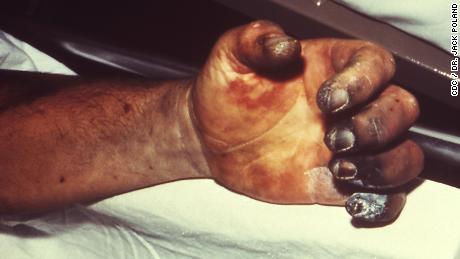Story highlights
- Leprosy and TB are all still prevalent around the world
- Plague still affects up to 3,000 people a year
- To date, smallpox is the only disease to have ever been eradicated
(CNN)This year, the United States has recorded 16 cases of plague, while recent figures have revealed that in the UK, cases of "19th-century" diseases such as scurvy and scarlet fever are on the rise.
Changes to our living conditions and the development of medicines have affected the rise and fall of diseases, but they seldom disappear. To date, smallpox remains the only disease to have ever been eradicated.
More about 'Unseen Enemy'
Go to CNN.com/unseenenemy for more stories and resources about epidemics, pandemics and the CNN Films documentary, "Unseen Enemy."
Here are some often-forgotten diseases that still exist -- despite our best efforts to control them.
Plague
In the 14th century, plague -- known as the Black Death -- killed an estimated 60% of the European population. Plague is spread by fleas living on rodents, such as rats and squirrels, but the development vaccines and antibiotics, and improved living conditions, have curtailed the spread of the disease
Plague is rare in developed countries today, with roughly two to 10 cases reported in the United States annually, where there have been 16 cases so far this year.
But the disease persists elsewhere. The WHO reports 1,000 to 3,000 global cases of plague every year. Africa, South America and Asia have the greatest number of cases -- particularly Madagascar, Peru and India.
Rubella
The virus, which is passed to babies in the womb from unvaccinated mothers, can cause multiple birth defects as well as fetal death when contracted by women during pregnancy.
Rubella vaccinations first became available in 1970, helping many developed countries come close to eliminating the disease and in April 2015, the Americas became the first region to eliminate rubella, after a 15-year vaccination campaign.
But the infection remains in countries with low immunization coverage, particularly in Africa and south-east Asia. An estimated 110,000 babies are born with Congenital Rubella Syndrome every year.
Leprosy
Leprosy is a contagious disease transmitted by prolonged contact with infected people. It causes damage to nerve and skin cells resulting in disfiguring sores and permanent disabilities.
The first breakthrough in leprosy treatment came in 1945, with the drug dapsone, but bacteria soon became resistant. This lead to the development of a successful multidrug therapy in the 1970s.
The number of global leprosy cases has dropped significantly in the last 30 years, from 5.2 million in 1985 -- but there were still 216,000 cases in 2013. The disease is still a problem in parts of India, Brazil and Indonesia where more than 80% of cases occur.
Gout
Gout is a type of arthritis caused by the build up of uric acid or urates -- a natural by-product of digestion -- inside joints. This can lead to pain, swelling and redness. First identified by the Egyptians, Gout was once known as the "disease of kings" because of its links to excessive food and alcohol consumption.
Unhealthy lifestyles and obesity have caused dramatic increases of gout in developed countries, with the condition now affecting an estimated 8.3 million North Americans -- nearly 4% of the adult population -- according to one study.
The prevalence of gout varies significantly around the world -- at 4.75% Greece has the highest rate in Europe, according to a 2010 study.
Whooping cough
Whopping cough, or pertussis, is an airborne infection that swells the airways. It causes intense coughing, with particularly serious effects for babies.
Before the 1940s there were more than 200,000 cases of whooping cough in the United States each year, until widespread vaccination reduced new infections by 80%. But outbreaks still occur. In 2010, California suffered its worst outbreak in 60 years, with close to 1,500 cases and 10 deaths.
There were an estimated 16 million global cases in 2008 -- 95% in developing countries -- killing about 195,000 children.
Diphtheria
This disease affects the nose and throat and is passed on by coughing or sneezing. It kills 5-10% of patients who catch it.
It was once a major childhood killer. The United States recorded 206,000 cases in 1921, causing more than 15,000 deaths.
Vaccination programs meant it declined rapidly, with only five cases of diphtheria reported in the United States in the last decade. But in the developing world it remains a problem.
In 2011 nearly 5,000 cases of diphtheria were recorded globally, with many more likely unreported. It continues to be a problem in parts of Africa and Asia -- mostly due to poor vaccination coverage.
Scarlet fever
This disease is caused by bacteria found on the skin and throat, producing a distinctive pink-red rash. The bacteria is spread by sneezing and coughing, touching skin with infections such as impetigo, or sharing contaminated linen. There is still no vaccine.
From 1840 to 1883, fatality rates of scarlet fever exceeded 30% in some parts of the U.S. and Europe. But from the 1950s, antibiotics and improved living conditions made the disease rare in developed countries.
In 2014, more than 14,000 cases of Scarlet fever were reported in the United Kingdom -- the highest surge since the late 1960s -- and infections have continued in 2015. Globally, outbreaks of this rare disease continue to occur -- though rare -- with 1,500 cases and two fatalities reported in Hong Kong in 2011.
TB
Known as the "White Plague" as it ravaged 18th-century Europe, tuberculosis (TB) is now the world's biggest infectious killer, ahead of HIV.
More than 9,400 people were infected in the United States in 2014. Globally, TB killed an estimated 1.5 million people in 2013, whilst 9 million developed the disease. TB is treatable but drug-resistant forms cause further challenges in controlling the disease.
The infection is spread through the air, aided by overcrowded housing and poor ventilation. Strong immune systems can normally fight off the disease but TB takes hold in patients with weakened defenses -- particularly people with HIV.
Rickets
Rickets is a disease that softens and bends children's bones. Commonly caused by a lack of vitamin D and calcium, it's often thought of as a 19th-century condition.
Autopsy studies in parts of the Netherlands showed that in the late 19th century, 80-90% of children had rickets, but improved living conditions in developed countries made the disease so rare that many governments stopped tracking it.
Although there's a lack of comprehensive data on the global rates of rickets, experts believe that less time spent outdoors (sunlight is converted into Vitamin D) combined with inadequate Vitamin D and calcium in some diets, is causing it to make a comeback in developed countries.
Polio
Humans have been living with polio for thousands of years. The virus spreads through contact with infected feces or sneeze droplets, reaching the brain and spinal cord and causing paralysis in some cases. In the 1940s and 1950s, in the U.S. alone about 35,000 people annually became disabled because of polio.
Effective vaccines were developed in the 1950s and 60s. When the Global Polio Eradication Initiative began in 1988, polio paralyzed more than 1,000 children worldwide every day. Since then, more than 2.5 billion children have been immunized, decreasing global polio cases by 99%.
In 2015, just 51 cases of wild polio virus have been reported so far, all in Afghanistan and Pakistan.































